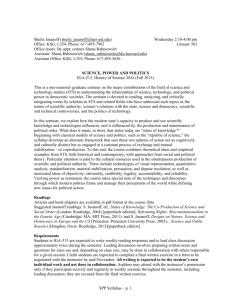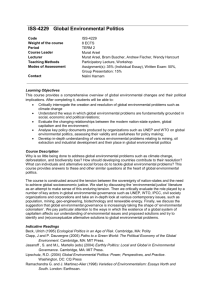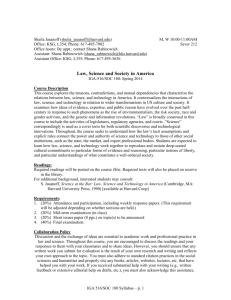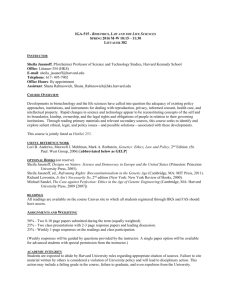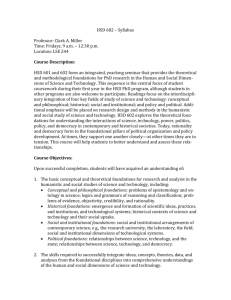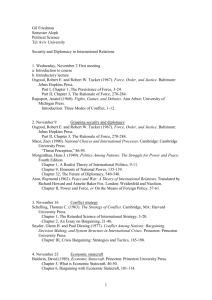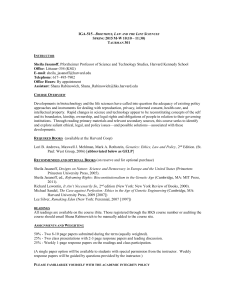Sheila Jasanoff (sheila_jasanoff@harvard
advertisement
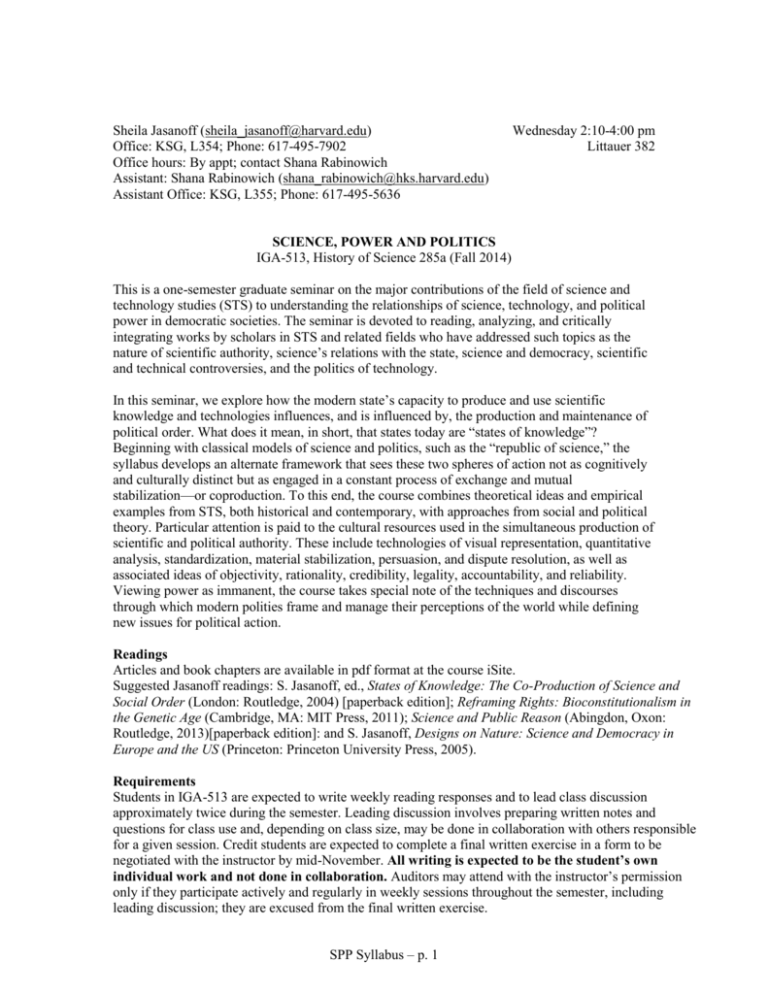
Sheila Jasanoff (sheila_jasanoff@harvard.edu) Office: KSG, L354; Phone: 617-495-7902 Office hours: By appt; contact Shana Rabinowich Assistant: Shana Rabinowich (shana_rabinowich@hks.harvard.edu) Assistant Office: KSG, L355; Phone: 617-495-5636 Wednesday 2:10-4:00 pm Littauer 382 SCIENCE, POWER AND POLITICS IGA-513, History of Science 285a (Fall 2014) This is a one-semester graduate seminar on the major contributions of the field of science and technology studies (STS) to understanding the relationships of science, technology, and political power in democratic societies. The seminar is devoted to reading, analyzing, and critically integrating works by scholars in STS and related fields who have addressed such topics as the nature of scientific authority, science’s relations with the state, science and democracy, scientific and technical controversies, and the politics of technology. In this seminar, we explore how the modern state’s capacity to produce and use scientific knowledge and technologies influences, and is influenced by, the production and maintenance of political order. What does it mean, in short, that states today are “states of knowledge”? Beginning with classical models of science and politics, such as the “republic of science,” the syllabus develops an alternate framework that sees these two spheres of action not as cognitively and culturally distinct but as engaged in a constant process of exchange and mutual stabilization—or coproduction. To this end, the course combines theoretical ideas and empirical examples from STS, both historical and contemporary, with approaches from social and political theory. Particular attention is paid to the cultural resources used in the simultaneous production of scientific and political authority. These include technologies of visual representation, quantitative analysis, standardization, material stabilization, persuasion, and dispute resolution, as well as associated ideas of objectivity, rationality, credibility, legality, accountability, and reliability. Viewing power as immanent, the course takes special note of the techniques and discourses through which modern polities frame and manage their perceptions of the world while defining new issues for political action. Readings Articles and book chapters are available in pdf format at the course iSite. Suggested Jasanoff readings: S. Jasanoff, ed., States of Knowledge: The Co-Production of Science and Social Order (London: Routledge, 2004) [paperback edition]; Reframing Rights: Bioconstitutionalism in the Genetic Age (Cambridge, MA: MIT Press, 2011); Science and Public Reason (Abingdon, Oxon: Routledge, 2013)[paperback edition]: and S. Jasanoff, Designs on Nature: Science and Democracy in Europe and the US (Princeton: Princeton University Press, 2005). Requirements Students in IGA-513 are expected to write weekly reading responses and to lead class discussion approximately twice during the semester. Leading discussion involves preparing written notes and questions for class use and, depending on class size, may be done in collaboration with others responsible for a given session. Credit students are expected to complete a final written exercise in a form to be negotiated with the instructor by mid-November. All writing is expected to be the student’s own individual work and not done in collaboration. Auditors may attend with the instructor’s permission only if they participate actively and regularly in weekly sessions throughout the semester, including leading discussion; they are excused from the final written exercise. SPP Syllabus – p. 1 SYLLABUS September 3: Introduction and Overview What does the field of Science and Technology Studies (STS) bring to the study of power, politics, and policy? How do the organization and materials of the course reflect perspectives from STS, and how do these relate to work in other social science fields? What major themes does the course develop, and what is expected from students? We introduce the idea of public reason, which forms a backbone of the course. Also, in-class self-introductions, explanations of people’s interest in the course—and questions about it. Suggested: S. Pinker, “Science Is Not Your Enemy,” New Republic, August 6, 2013, http://www.newrepublic.com/article/114127/science-not-enemy-humanities. S. Poole, Rejoinder to Pinker, The Guardian, August 23, 2013, http://www.theguardian.com/books/2013/aug/23/steven-pinker-language-poole. The Chomsky-Foucault Debate [excerpt, part 1/2], http://www.youtube.com/watch?v=W9S1CiGPX2Q Chomsky Disagrees, http://www.youtube.com/watch?v=dAqVBlf2mSc&NR=1 September 10: STS Analytic Frameworks – Contingency and Interpretive Flexibility What does STS add to the analysis of power and authority? What is at stake in questioning “realist” views of scientific knowledge or technological systems? How have other disciplines tackled the theme of contingency (or context-dependence), and how can we relate those writings to STS work? How can artifacts and ideas be socially constructed and yet be seen as if they are not social? Put differently, how should we problematize stable demarcations in ideas and things, and how do our answers bear on the study of politics and power? W.B.Gallie, “Essentially Contested Concepts,” Proceedings of the Aristotelian Society, 56:167198 (1956). D. Bloor, Knowledge and Social Imagery (Chicago: University of Chicago Press, 1991 [1976]), Ch. 1 (“The Strong Programme in the Sociology of Knowledge”), pp. 3-23. T.F. Gieryn, “The Boundaries of Science,” in S. Jasanoff et al., eds., Handbook of Science and Technology Studies (Thousand Oaks, CA: Sage Publications, 1995), pp. 393-443. M. Callon, “Some Elements of a Sociology of Translation: Domestication of the Scallops and the Fishermen of St. Brieuc Bay,” in J. Law, ed., Power, Action, and Belief: A New Sociology of Knowledge? (London: Routledge and Kegan Paul, 1986), pp. 196-233. S. L. Star and J. R. Griesemer, “Institutional Ecology, ‘Translations’ and Boundary Objects: Amateurs and Professionals in Berkeley’s Museum of Vertebrate Zoology, 1907-39,” Social Studies of Science 19(3): 387-420 (1989). D. Haraway, Simians, Cyborgs and Women (London: Routledge, 1991), Ch. 9 (“Situated Knowledges: The Science Question in Feminism and the Privilege of Partial Perspective”), pp. 183-201. Strongly recommended: I. Hacking, The Social Construction of What? (Cambridge, MA: Harvard University Press, 1999), Ch. 2 (“Too Many Metaphors”), pp. 35-62. Suggested: P. Kitcher, Science, Truth, and Democracy (Oxford: Oxford University Press, 2001), Ch. 4 (“The World as We Make It”), pp. 43-53. A. MacIntyre, After Virtue, 3rd ed. (Notre Dame: University of Notre Dame Press, 2007), Ch. 7 (‘Fact’, Explanation and Expertise), pp. 79-87. SPP Syllabus – p. 2 September 17: Autonomy and Self-Governance Is science a distinct organizational form, a culture, an interest group, or a model political system? How do we know? Using what criteria? Can science be self-governing? Does our characterization of science matter to our characterizations of politics? M. Polanyi, “The Republic of Science,” Minerva 1:54-73 (1962). R. K. Merton, “The Normative Structure of Science,” in R.K. Merton, The Sociology of Science: Theoretical and Empirical Investigations (Chicago: University of Chicago Press, 1973), pp. 267-278. M. J. Mulkay, “Norms and Ideology in Science,” Social Science Information 15:637-656 (1976). B. Latour. “Give Me a Laboratory and I Will Raise the World,” in M. Biagioli, ed., The Science Studies Reader (New York: Routledge, 1999), pp. 258-275 E. F. Keller, Reflections on Gender in Science (New Haven: Yale University Press, 1985), pp. 7594. S. Visvanathan, A Carnival for Science Delhi: Oxford University Press, 1997), Ch. 2 (“On the Annals of the Laboratory State”), pp. 15-47. H. Nowotny, P. Scott and M. Gibbons, Re-Thinking Science: Knowledge and the Public in an Age of Uncertainty (Cambridge: Polity, 2001), Ch. 3 (“The Co-Evolution of Society and Science”), pp. 30-49. S. Jasanoff, “Genealogies of STS,” Social Studies of Science 42(3) (2012). pp. 435-441. Strongly recommended: L. Fleck, Genesis and Development of a Scientific Fact (Chicago: University of Chicago Press, 1979), Ch. 2 (“Epistemological Conclusions from the Established History of a Concept”), pp. 20-51. Suggested: D.K. Price, The Scientific Estate (Cambridge, MA: Harvard University Press, 1965), Ch. 1 (“Escape to the Endless Frontier”), pp. 1-20. D.H. Guston, Between Politics and Science (New York: Cambridge University Press, 2000), Ch. 2 (“Understanding the Social Contract for Science”), pp. 37-63. September 24: Constitutions of Modernity -- The Co-Production of Science and Politics How does the constitution of knowledge relate to political constitution-making and the constitution of nation states? How do modern states constitute themselves as knowledgeable and capable of deploying knowledge for public purposes? How do knowledge and knowledgebased technologies function to advance or impede the expression of democratic values? S. Jasanoff, ed., States of Knowledge: The Co-Production of Science and Social Order (London: Routledge, 2004), Ch. 2 (“Ordering Knowledge, Ordering Society”), pp. 13-45. B. Latour, We Have Never Been Modern (Cambridge: Harvard University Press, 1993), Chs. 1-2, pp. 1-48. B. Anderson, Imagined Communities, Chs. 1-3, pp. 1-65. Y. Ezrahi, The Descent of Icarus (Cambridge, MA: Harvard University Press, 1990), Ch. 2 (“Science and the Making of Representative Actions”), pp. 41-66. S. Jasanoff, “In a Constitutional Moment: Science and Social Order at the Millennium,” in B. Joerges and H. Nowotny, eds., Social Studies of Science and Technology: Looking Back, Ahead, (Dordrecht: Kluwer, 2003), pp. 155-180. J. Krige, American Hegemony and the Postwar Reconstruction of Science in Europe (Cambridge, MA: MIT Press, 2006), Ch. 1 (“Basic Science and the Coproduction of American Hegemony”), pp. 1-14. Suggested: SPP Syllabus – p. 3 D.K. Price, The Scientific Estate, Ch. 6 (“Constitutional Relativity”), pp. 163-207. D. S. Greenberg, Science, Money, and Politics: Political Triumph and Ethical Erosion (Chicago: University of Chicago Press, 2001), Ch. 3 (“Vannevar Bush and the Myth of Creation”), pp. 41-58. October 1: Networks, Materiality, and Power How does materiality affect the exercise of power, and vice versa? What makes technological systems take the forms they take? How do machines and nonhumans interact with social actors? How should we think about the exercise of epistemic and technological power across borders, especially when we consider the interpretive flexibility of knowledge and its material forms? Y. Ezrahi, Descent of Icarus, Ch. 6 (“Machines and Images of Order”), pp. 149-166. B. Latour, “Third Source of Uncertainty: Objects too Have Agency,” in Reassembling the Social: An Introduction to Actor-Network Theory (Oxford: Oxford University Press, 2005), 6386. W. Bijker, T. Pinch and T. Hughes, eds., The Social Construction of Technological Systems (Cambridge, MA: MIT Press, 1987), Ch. 1 (Pinch and Bijker, “The Social Construction of Facts and Artifacts”), pp. 17-50. L. Winner, “Do Artifacts Have Politics,” in The Whale and the Reactor (Chicago: University of Chicago Press, 1986), pp. 19-39. C. Thompson, “Co-Producing CITES and the African Elephant,” in Jasanoff, States of Knowledge, Ch. 4, pp. 67-86. S. Jasanoff and S-H. Kim, ““Containing the Atom: Sociotechnical Imaginaries and Nuclear Regulation in the U.S. and South Korea,” Minerva 47(2):119-146 (2009). Suggested: L. Winner, “Upon Opening the Black Box and Finding It Empty: Social Constructivism and the Philosophy of Technology,” Science, Technology, and Human Values 18:362-378 (1993). B. Joerges, “Do Politics Have Artefacts,” Social Studies of Science 29 (1999), pp. 411-431. A. Mol and J. Law, “Regions, Networks and Fluids: Anaemia and Social Topology,” Social Studies of Science 24 (1994), pp. 641-671. October 8: Constitutive Visions How does seeing influence the making of a communal political space and the legitimation of the rules that bind polities together? How does the interpretive flexibility of seeing get disciplined to make points of view that we consider “objective”? How are particular “witness” positions authorized? In other words, whose sight matters in the public domain? M. Foucault, Discipline and Punish (New York: Vintage, 1979), Part III, Ch. 3 (“Panopticism”), pp. 195-228. Shapin and Schaffer, Leviathan, Ch. 2 (“Seeing and Believing”), pp. 22-79. B. Latour, “Drawing Things Together,” in M. Lynch and S. Woolgar, eds. Representation in Scientific Practice (Cambridge, MA: MIT Press, 1990), pp. 19-68. D. Haraway, Primate Visions (New York: Routledge, 1989), Ch. 3 (“Teddy Bear Patriarchy”), pp. 26-58. J. C. Scott, Seeing Like a State (New Haven: Yale University Press, 1998), Ch. 1 (“Nature and Space”) and Ch. 3 (“Authoritarian High Modernism”), pp. 1-52, 87-102. J. Ferguson, “Seeing Like an Oil Company: Space, Security, and Global Capital in Neoliberal Africa,” American Anthropologist 107(3):377-382 (2005). M. Mahony, “The Predictive State: Science, Territory and the Future of the Indian Climate,” Social Studies of Science 44(1):109-133 (2014) SPP Syllabus – p. 4 Suggested: M. Foucault, The Order of Things (New York: Vintage, 1973), pp. 3-16. S. Alpers, “Interpretation without Representation, or, The Viewing of Las Meninas,” Representations 1 (1983), pp. 30-42 [available through JSTOR]. S. Jasanoff, “Image and Imagination: The Formation of Global Environmental Consciousness,” in C. Miller and P. Edwards, eds., Changing the Atmosphere: Expert Knowledge and Environmental Governance (Cambridge, MA: MIT Press, 2001), pp. 309-337. October 15: The Politics of Numbers – Statistics and Indicators Quantification and calculation are considered by many to be the most powerful technologies for producing objectivity, and we rely on (ac)counting to establish the legitimacy of many kinds of political decisions. But how apolitical are numbers? How do they mediate politics? A. Desrosières, “How to Make Things Which Hold Together: Social Science, Statistics and the State,” in P. Wagner, B. Wittrock, and R. Whitley, eds., Discourses on Society: The Shaping of the Social Science Disciplines (Dordrecht: Kluwer, 1991), pp. 195-218. T. Porter, Trust in Numbers (Princeton, NJ: Princeton University Press, 1995), Ch. 7 (“U.S. Army Engineers and the Rise of Cost-Benefit Analysis”), pp. 148-189. J. Carson, “The Science of Merit and the Merit of Science: Mental Order and Social Order in Early 20th Century France and America,” in Jasanoff, States of Knowledge, pp. 181-205. M. Power, The Audit Society (Oxford: Oxford University Press, 1997), Ch. 5 (“Audit Knowledge and the Construction of Auditees”), pp. 91-121 W. Espeland and M. Sauder, “Rankings and Reactivity: How Public Measures Recreate Social Worlds,” American Journal of Sociology 113 (1) (2007), pp. 1-40. A. S. Mathews, “Scandals, Audits and Fictions: Linking Climate Change to Mexican Forests,” Social Studies of Science 44(1):82-108 (2014). J. Rudgren, “Civilian or Not? New Fight in Tallying the Dead From the Gaza Conflict,” New York Times, August 5, 2014, http://www.nytimes.com/2014/08/06/world/middleeast/civilian-or-not-new-fight-intallying-the-dead-from-the-gaza-conflict.html. Strongly recommended: Documentary: E. Morris, The Fog of War. Suggested: M. Strathern, “Introduction: New Accountabilities; “Afterword: Accountability and Ethnography,” in Strathern, ed., Audit cultures. Anthropological studies in accountability, ethics and the academy [EASA series in Social Anthropology], (London: Routledge, 2000). October 22: Science, State, and Markets How do theories of capital reflect our notions of structure and agency? Is it useful to think of knowledge as a form of capital? Markets depend on calculation, but are there forms of capital that elude calculation? How do people acquire the power or the right to calculate for others? P. Bourdieu, “The Forms of Capital,” in J. G. Richardson, ed., Handbook of Theory and Research for the Sociology of Education (New York: Greenwood Press, 1986), pp. 241-258. R. D. Putnam, “Bowling Alone: America’s Declining Social Capital,” Journal of Democracy 6(1) (1995), pp. 65-78, http://muse.jhu.edu.ezpprod1.hul.harvard.edu/journals/jod/v006/6.1putnam.html. T. Mitchell, Rule of Experts: Egypt, Techno-Politics, Modernity (Berkeley: University of California Press, 2002), Ch. 3 (“The Character of Calculability”), pp. 80-119. SPP Syllabus – p. 5 K. Sunder Rajan, “Two Tales of Genomics: Capital, Epistemology, and Global Constitutions of the Biomedical Subject,” Ch.9 in S. Jasanoff, ed., Reframing Rights, pp. 193-216. M. Callon and F. Muniesa, “Economic Markets as Calculative Collective Devices,” Organization Studies 26(8):1229–1250 (2005). D. MacKenzie, “Making Things the Same: Gases, Emission Rights and the Politics of Carbon Markets,” Accounting, Organizations and Society 34(30-4):440-455 (2009). E. Rosenthal and E. W. Lehren, “Profits on Carbon Credits Drive Output of a Harmful Gas,” New York Times, August 8, 2012, http://www.nytimes.com/2012/08/09/world/asia/incentiveto-slow-climate-change-drives-output-of-harmful-gases.html?pagewanted=all. Suggested: M. Fourcade, “Theories of Markets and Theories of Society,” American Behavioral Scientist 50: 1015-1034 (2007). October 29: Objectivity – The Display of Public Reason Reason in public life does not consist merely of justifying official decisions with reference to pre-existing principles in designated political fora. Rather, reason results from active performances, enactments, and embodiments of agreed-upon forms of rationality in varied cultural domains, not all of which are recognizably “political .” What are some of the most prominent strategies for displaying public reason in contemporary political systems? How do they integrate knowledge with power? S. Shapin and S. Schaffer, Leviathan and the Air-Pump (Princeton: Princeton University Press, 1985), Ch. 8 (“The Polity of Science: Conclusions”), pp. 332-344. B. Anderson, Imagined Communities, Ch. 10 (“Census, Map, Museum”), pp. 163-185. Y. Ezrahi, Descent of Icarus, Ch. 3 (“Science and the Visual Culture of Liberal-Democratic Politics”), pp. 67-96. L. Daston and P. Galison, “The Image of Objectivity,” Representations 40 (1992), pp. 81-128. S. Hilgartner, Science on Stage: Expert Advice as Public Drama (Stanford, CA: Stanford University Press, 2000), Introduction, pp. 3-41. S. Jasanoff, “The Practices of Objectivity in Regulatory Science,” in C. Camic, N. Gross, and M. Lamont, eds., Social Knowledge in the Making (Chicago: University of Chicago Press, 2011), pp. 307-337. Suggested: P. Galison, “Aufbau/Bauhaus: Logical Positivism and Architectural Modernism,” Critical Inquiry 16(4) (1990), pp. 709-752. I. Buruma, Wages of Guilt (London: Vintage, 1995), Part III (“Memorials, Museums and Monuments”). T. F. Gieryn, “Balancing Acts: Science, Enola Gay and History Wars at the Smithsonian,” in S. Macdonald, The Politics of Display (London: Routledge, 1998), pp. 197-227. November 5: The Politics of Normalization Many social arrangements and political decisions hinge on determinations of what counts as normal: in identity, behavior, social relationships. How are these normalizing moves made in society, where do standards of normality come from, and how do they reflect the institutionalization and exercise of power? How do ideas of normality relate to judgments concerning sameness and difference? M. Foucault, Discipline and Punish, Part III, Ch. 2 (“The means of correct training”), pp. 170194. I. Hacking, Rewriting the Soul (Princeton, NJ: Princeton University Press, 1995), Ch. 4 (“Child Abuse”), pp. 55-68. SPP Syllabus – p. 6 W. Anderson, “The Possession of Kuru: Medical Science and Biocolonial Exchange,” Comparative Studies in Society and History 42(4):713-744 (2000). G. C. Bowker and S. L. Star, Sorting Things Out: Classification and Its Consequences (Cambridge, MA: MIT Press, 2000), Ch. 6 (“The Case of Race Classification and Reclassification Under Apartheid”), pp. 195-225. S. Epstein, Inclusion: The Politics of Difference in Medical Research (Chicago: University of Chicago Press, 2007), Ch. 11 (“Sex Differences and the New Politics of Women’s Health”), pp. 233-257. J. E. Reardon, “Human Population Genomics and the Dilemma of Difference,” Ch. 10 in S. Jasanoff ed., Reframing Rights, pp. 217-238. Suggested: Z. Bauman, Modernity and Ambivalence (Ithaca, NY: Cornell University Press, 1991), pp. 18-52. M. Minow, Making All the Difference (Ithaca, NY: Cornell University Press, 1990), Ch. 2 (“Sources of Difference”), pp. 49-78. November 12: Discourses of Reason Politics in complex societies is the art of living with irresolvable conflicts and irreducible uncertainties – cognitive, moral, social. How do polities make judgments that most citizens are willing to accept as binding, if not legitimate? What is the role of institutions? How do technical discourses (not just science but also law and ethics) reduce uncertainty in the political realm? Why do they sometimes fail? S. Shapin, “Cordelia’s Love: Credibility and the Social Studies of Science,” Perspectives on Science 3 (1995), pp. 255-275. M. Strathern, “The Tyranny of Transparency,” British Educational Research Journal 26(3) (2000), pp. 309-321. B. Wynne, “Reflexing Complexity: Post-genomic Knowledge and Reductionist Returns in Public Science,” Theory, Culture & Society 22(5):67-94 (2005). C. Cohn, “Nuclear Language and How We Learned to Pat the Bomb,” Bulletin of the Atomic Scientists 43(5):17-24 (June 1987). http://www.genderandsecurity.org/Cohn_Nuclear_Language.pdf S. Jasanoff, “Making the Facts of Life,” in Jasanoff, ed., Reframing Rights, pp. 59-83. L. Stark, Behind Closed Doors: IRBs and the Making of Ethical Research (Chicago: University of Chicago Press, 2012), Ch. 1 (“Everyone’s an Expert?”), pp. 21-39. Suggested: S. Jasanoff, ed., Reframing Rights: Bioconstitutionalism in the Genetic Age (Cambridge, MA: MIT Press, 2011), Ch. 1 (“Rewriting Life, Reframing Rights”), pp. 1-27. J. Evans, “Between Technocracy and Democratic Legitimation: A Proposed Compromise Position for Common Morality Public Bioethics,” Journal of Medicine and Philosophy 31(3):213-234 (2006). November 19: Publics and Citizens in the Knowledge State Who is the “demos” or the “public” that democracy seeks to serve? How has the advent of science and technology affected the ways in which we conceptualize and represent publics and citizens? How do publics emerge, and who gets to orchestrate their emergence? What opportunities exist for active intervention by citizens in the knowledge-making practices of modern states? How does political culture matter in the production of knowledgeable citizens? J. Dewey, The Public and Its Problems (New York: Henry Holt, 1927), Ch. 1 (“Search for the Public”), pp. 3-36. SPP Syllabus – p. 7 B. Wynne, “Misunderstood Misunderstandings: Social Identities and Public Uptake of Science,” in A. Irwin and B. Wynne, eds., Misunderstanding Science? The Public Reconstruction of Science and Technology (Cambridge: Cambridge University Press, 1996), pp. 19-46. R. H. Thaler and C. S. Sunstein, Nudge: Improving Decisions about Health, Wealth, and Happiness (New Haven: Yale University Press, 2008), Introduction, pp. 1-14. M. Kusch, “Towards a Political Philosophy of Risk,” in T. Lewens, ed., Risk: Philosophical Perspectives (London: Routledge, 2007), pp.131-155. A. Petryna, Life Exposed: Biological Citizens after Chernobyl (Princeton, NJ: Princeton University Press, 2002), Ch. 5 (“Biological Citizenship”), pp. 115-148. S. Jasanoff, Designs on Nature: Science and Democracy in Europe and the United States (Princeton, NJ: Princeton University Press, 2005), Ch. 10 (“Civic Epistemology”), pp. 247-271. Video, NSA Whistleblower Edward Snowden: “I don’t want to live in a society that does these sorts of things,” http://www.youtube.com/watch?v=5yB3n9fu-rM. Suggested: M. Hardt and A. Negri, Empire (Cambridge, MA: Harvard University Press, 2000), Ch. 2 (“Biopolitical Production”), pp. 22-41. *** THANKSGIVING BREAK: NO CLASS NOVEMBER 26 *** December 3: Revisiting Democracy through STS Does STS push us to redefine the concept of representative democracy, and if so how? How can the voice(s) of the demos be adequately represented? What is the role of experts? Must the idea of politics be expanded to sites other than the nation state and to actors other than humans? Which ones, and with what implications and consequences? B. Latour, Politics of Nature: How to Bring the Sciences Into Democracy (Cambridge, MA: Harvard University Press, 2004), Ch. 2 (“How to Bring the Collective Together”). M. Callon, P. Lascoumes, and Y. Barthe, Acting in an Uncertain World: An Essay on Technical Democracy (Cambridge, MA: MIT Press, 2009), Ch. 4 (“In Search of a Common World”), pp. 106-152. Y. Ezrahi, “Science and the Political Imagination in Contemporary Democracies,” in Jasanoff, ed., States of Knowledge, pp. 254-273. A. Liptak, “Justices, 5-4, Reject Corporate Spending Limit,” New York Times, January 21, 2010, http://www.nytimes.com/2010/01/22/us/politics/22scotus.html?pagewanted=all. R. Doubleday and B. Wynne, “Despotism and Democracy in the United Kingdom: Experiments in Reframing Citizenship,” in S. Jasanoff, ed., Reframing Rights, pp. 239-261. S. Visvanathan, “Knowledge, Justice and Democracy,” in M. Leach, I. Scoones and B. Wynne, eds., Science and Citizens (London: Zed Books, 2005), pp. 83-94. S. Jasanoff, “A New Climate for Society,” Theory, Culture & Society 27(2-3):233-253 (March/May 2010). Suggested: C.D. Stone, Should Trees Have Standing? (Oceana Publications, 1996). M.J. Smithson, “Social Theories of Ignorance,” in R.N. Proctor and L. Schiebinger, eds., Agnotology: The Making and Unmaking of Ignorance (Stanford, CA: Stanford University Press, 2008), pp. 209-229. A. Irwin, “STS Perspectives on Scientific Governance,” in E. Hackett et al., eds. Handbook of STS, 3rd edition (Cambridge, MA: MIT Press, 2007), pp. 583-607. SPP Syllabus – p. 8
